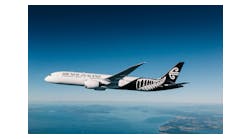When it comes to safety and maintenance issues, even the most dedicated competitors in the airline industry become willing collaborators and this sense of common purpose extends to manufacturers as well. Almost every airliner built in the last half century has been given life by a launch customer that took the risk of being first off the blocks with a new design or model upgrade.
However, when looking at the development relationship for the B787 between Boeing and All Nippon Airways (ANA, NH), one finds a paradigm on steroids that continues to this day.
Boeing Bias
ANA has been a Boeing operator for 50 years and has operated every aircraft type except the B707 and B757, so the relationship was strong to begin with. Beginning in 2002, ANA was part of a group that decided to green-light the 787 project. Two years later, in mid-2004, ANA placed its first order for 50 of the aircraft — the first non-U.S. carrier to commit. ANA also established a permanent team, residing in Seattle, to work with Boeing on the development of the aircraft and its entry into service.
Anyone following aviation will be well aware of the problems that ensued between that first order and entry of the airplane into service. Originally planned for spring 2008, ANA did not receive its first aircraft until September 2011 and the first commercial service was launched on October 26.
And then in January 2013, the aircraft was grounded due to fires related to its lithium-ion batteries. (Having been invited for the first flight from San Jose, I was amongst those rerouted due to the grounding.) All in all, one might call this whole process a bit rocky. And through it all, as the launch customer and largest operator, ANA worked unstintingly with Boeing to correct the problems and bring the aircraft up to its promised potential. Both Boeing and ANA cite this intense cooperation as vital to the aircraft’s development and successful integration into fleets worldwide.
ANA was also working with Boeing as it began to expand the program to include the -9 and -10 variants. The two companies adopted a slogan “working together” that symbolized the joint effort to fashion an innovative aircraft by using input from both the manufacturer and the user.
Promise Realized
And it has paid off over time. In mid-2015 ANA took delivery of its 50th 787, a -9 model. That record of 50 aircraft in less than five years makes ANA the largest customer and operator of the 787 series. With its growing fleet, much of the potential foreseen when the aircraft was developed, has come to fruition. Trans Pacific routes to San Jose, Seattle, and Mexico are viable because of the aircraft’s smaller size and favorable operating economics.
Compared to the B767 that it is primarily replacing, fuel costs are down by 20 percent and the wing’s higher aspect ratio boosts efficiency by another 7 percent. By eliminating bleed systems from the engines they have achieved higher power ratings and greater reliability.
When it receives its first -10 aircraft, ANA will be the first airline to operate all three variants which bring network advantages by being able to more accurately align supply with demand across 787 routes. The initial route for the -10 is yet to be determined.
Rolls-Royce, maker of ANA’s 787 engines, is being tasked with the production of a higher thrust engine which will boost the aircraft’s capabilities. (The corrosion issue that arose in 2016 has been fully addressed by RR.)
Straight from the Man in Charge
Noboru Okada, the airline’s manager for engineering planning and administration, says that his experience and that of his team, has been as expected, but with lots of initial systems problems — and of course the delays. But he notes that many such difficulties were within normal bounds for a launch customer and many of those hurdles were less bothersome due to the unique relationship between ANA and Boeing.
Due to its carbon fiber construction, ultrasound is a valuable tool in finding damage that may not be visible on the surface. And the use of that material has resulted in a 20 percent cost savings with regards to structure — primarily through the absence of corrosion.
Also due to the size of the fleet and accumulated experience with the 787, ANA has improved and upgraded systems over time so that the present dispatch reliability for the Dreamliner fleet is well above 99 percent. And given the newsworthiness of early problems with the 787, Okada says that overall, in retrospect, the teething problems with the 787 have been on a par with the airline's triple-sevens, an aircraft with a much longer service record.
Multi-use and Popular
ANA uses its 787 fleet on doth domestic and International routes, with the domestic models having a higher density seating configuration. For the -8, of the 36 aircraft, 25 are configured for international service and, as of the delivery of the 50th unit, almost all of the -9s were in a long-haul configuration. The ratio for the -10 remains undecided.
In domestic use, aircraft operate an average of six cycles per day while international usage is 12 to 13 hours per day. The aircraft’s larger windows, advanced LED lighting, higher humidity, and lower pressurization level have all made the 787 a customer favorite at ANA as well.
So, the word from those who know is that after a rough start, the 787 series has delivered with regards to reduced operational costs, simpler maintenance, and high customer satisfaction. It was a bet that has paid off richly.





